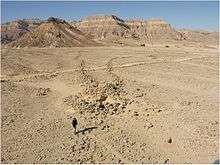Desert kite

Desert kites are constructions aimed at trapping game animals, found in the Middle East.[1]
The constructions are generally believed to have been used "to catch herds of wild ungulates."[2] They appear in deserts and are most common in eastern Jordan [3]; some also appear in the Negev Desert of Israel and Sinai Desert of Egypt.[2]
One review of 16 desert kites from the Negev and northeast Sinai, published in the Journal of Arid Environments in 2010, found that desert kites in these deserts were established in the late 4th millennium BCE or early 3rd millennium BCE and had ceased to function by the middle of the 2nd millennium BCE. Dating was established through radiocarbon, luminescence, and material culture methods.[2] This and other research established that kites were a more recent phenomenon than some had earlier suggested.[4]
Desert kites consist of long dry-stone walls converging on a neck which opens into a confined space which was used as the killing floor. The length of the walls can run to hundreds of metres and can be best seen from the air. They were given their name by pilots who first saw them from the air in the 1920s.[5] Almost 2,000 have been identified across Jordan and Syria[6]. No research has been done across the Saudi Arabian Desert.[7][8]
Rock art in the vicinity of some of the kites indicates that the hunt could represent a large social effort, done together by people from several settlements, and showing religious connotations.[4] Evidence from the Tell Kuran site in the Khabur River Basin of northeastern Syria indicates that Persian gazelles were hunted using kites, and that this contributed to that species' extirpation from the Levant.[4]
One large example in Jordan has tails 4 km long and must have been crossed without comment by Gertrude Bell.[9]
Another explorer who did not recognize what he was seeing was T.E. Lawrence. In 1913, whilst on an archeological survey of the Negev, Lawrence wrote about the area around Ain el Guderat:
Starting above this Byzantine village, and running eastward along the hill-top, there is one of the long and puzzling walls which, like those elsewhere in the Negeb, appear to start and go on and end so aimlessly. It is a wall of dry stone, perhaps three-quarters of a mile long in all, and still perfectly preserved. It has been piled up very carelessly, from two to three feet thick, and from three to five feet high. It runs reasonably directly along the hill, never at the crest, but always a little way down the valley slope; it crosses gullies on the hill-side, without varying its height or taking any regard of them; in one place it is broken by plain openings, flanked internally by a square enclosure, a few feet each way, like a pound, or a temporary shelter. Its purpose is mysterious.[10]
He goes on to speculate that they may have been built to prevent camels straying.
References
| Wikimedia Commons has media related to Desert kite – Archaeology site. |
- ↑ Maitland, F (1927). "The 'Works of the Old Men' in Arabia". Antiquity. 1 (2): 197–203. doi:10.1017/s0003598x00000405.
- 1 2 3 Holzer, A.; Avner, U.; Porat, N.; Horwitz, L. K. (2010-07-01). "Desert kites in the Negev desert and northeast Sinai: Their function, chronology and ecology". Journal of Arid Environments. 'Paleoenvironment' in Honour of Aharon Horowitz. 74 (7): 806–817. doi:10.1016/j.jaridenv.2009.12.001.
- ↑ Abu-Azizeh, W., Tarawneh, M. (2015). Out of the Harra; Desert kites in South-eastern Jordan. New results from the South Eastern Badia Archaeological Project. Arabian Archaeology and Epigraphy, 26: 95–119. https://onlinelibrary.wiley.com/doi/abs/10.1111/aae.12058
- 1 2 3 Guy Bar-Oz; Melinda Zeder; Frank Hole. "Role of mass-kill hunting strategies in the extirpation of Persian gazelle (Gazella subgutturosa) in the northern Levant". Proceedings of the National Academy of Sciences. 108 (18): 7345–7350. doi:10.1073/pnas.1017647108. PMC 3088574. Retrieved 22 October 2014.
- ↑ Helms, Svend (1981) Jawa. Lost City of the Black Desert. Methuen. ISBN 0-416-74080-4. p.39
- ↑ Tarawneh, M., Abu-Azizeh, W., Abudanah, F. (2017). Desert Kites and Campsites in Jibal al-Khashabiyeh: Results of the South Eastern Badia Archaeological Project, Jordan. Al-Hussein Bin Talal University Journal of Research, 2 (3): 54-81. http://www.ahu.edu.jo/ahuj/Issues/04619_%D8%A7%D9%84%D8%B9%D8%AF_%202%20%D8%A7%D9%84%D9%85%D8%AC%D9%84%D8%AF%203-2017_12_1_2018.pdf
- ↑ Helms.p.47
- ↑ "Desert Kites". The Megalithic Portal. Retrieved 22 October 2014.
- ↑ Kennedy, David and Bewly, Robert (2012) The Harret al-Shaam - From the Air and Space. Bulletin of the Council for British Research in the Levant 7. 2012. ISSN 1752-7260. p.60
- ↑ Woolley, C. Leonard and Lawrence, T.E. (1914-1915) The Wilderness of Zin. Palestine Exploration Fund Annual (2003 Edition). ISBN 1-900988-291. p. 83